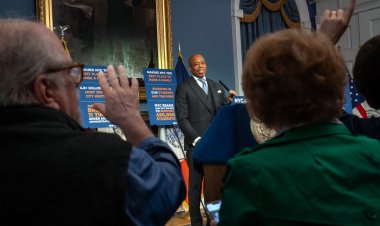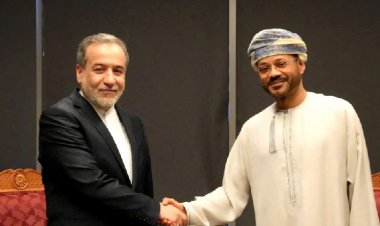Xi to Biden: Despite tensions, ‘turning our backs on each other’ not an option
High-stakes summit between the two leaders comes a year after their last face-to-face meeting.

WOODSIDE, Calif. — President Joe Biden and China’s Xi Jinping held a tightly-scripted diplomatic encounter Wednesday on the sidelines of a Pacific states summit aimed at calming fears over the U.S. and China drifting toward military conflict in the Indo-Pacific.
Biden and Xi rolled out a series of confidence-building measures — resumption of high-level military-to-military ties, a deal to address China’s role in the U.S. fentanyl crisis and an agreement on the military use of artificial intelligence — while talking past each other on key bilateral irritants including Taiwan, tech export controls and human rights.
That the two leaders were talking at all was the biggest takeaway of the summit.
Meeting for the first time in a year, Biden's primary audience were American partners in lockstep with his administration’s efforts to counter China’s growing diplomatic and military muscle. Xi targeted the international business community — including those who paid at least $2,000 per plate to hear him speak at a post-meeting corporate dinner Wednesday night — that China needs to lure back to resuscitate the nation’s sputtering economy.
“We have to ensure that competition does not veer into conflict. And we have to manage that responsibly, the competition,” Biden said at the start of the bilateral talks. He acknowledged that he and his counterpart did not always agree but, turning to Xi, called it “paramount that you and I understand each other clearly, leader to leader, with no misconception or miscommunication.”
Biden underscored the high stakes of the gathering, held on an olive tree-lined estate in a San Francisco suburb, declaring “the world” was watching its outcome. The relationship between Washington and Beijing will be a defining one for decades, but it has frayed badly amid a growing threat of military conflict between the world’s two largest economies that has pushed relations to their lowest point in a half century.
The need for candid conversations was echoed by Xi, who sat opposite Biden among a long conference table, both men flanked by senior aides. The Chinese leader nodded more directly toward the tensions between the two nations noting, through a translator, it had not been “smooth sailing” between Washington and Beijing. But he said that dialogue was needed since “turning our backs on each other is not realistic.”
Xi also downplayed the need for competition, noting the inherent differences between the U.S. and China and that it was not practical "for one side to try to shape the other.”
“Planet Earth is big enough for both countries to succeed,” Xi said, before the two sides began a closed-door meeting that lasted for roughly two hours.
The White House deliberately set low expectations for the meeting, both in terms of deliverables and for an evening news conference Biden scheduled to hold afterward. Officials stressed that the biggest accomplishment could be that the two men are talking at all. The administration’s goal, simply, was to turn back the clock and restore the bilateral relationship to where it was when the two men last met in Bali, Indonesia, before tensions escalated.
That meeting one year ago had been advertised as a breakthrough but the relationship soured months later. The presence of an alleged Chinese spy balloon over the continental U.S. in February, Beijing’s increasing saber rattling toward Taiwan, and new U.S. high-tech export restrictions targeting China further escalated tensions and the men have not spoken since.
Biden and Xi have a long history, and one that’s repeatedly cropped up for Biden as he sold himself to Americans in 2020 as a career statesman wise to other world leaders and their motivations. In one common refrain, he retold a story of meeting with Xi in southwest China when he was vice president. Xi asked him earnestly to define America, and Biden said, “possibilities.” Biden spoke of traveling extensively with Xi - and Xi invoked that trip in his remarks Wednesday - though the American leader would later use increasingly hot rhetoric to describe his Chinese counterpart.
The last year has further tested their resolve.
Biden will need to convince Xi that the U.S. and China still have wiggle room to cooperate. That’s a hard sell considering Biden calls Beijing a threat to the “rules based international order,” accuses it of committing genocide in Xinjiang against predominantly-Muslim Uyghurs, and has waged a three-year campaign to rally partners into coalitions that counter China’s growing diplomatic, economic and military muscle. Meanwhile, Xi earlier this year delivered a bellicose warning to Community Party officials that the U.S. was pursuing “comprehensive containment, encirclement and suppression against us.”
But the president still planned to press Xi on China’s ties with Iran, including how the Chinese leader could use his influence with Tehran to prevent Iran and its proxies from turning the Israel-Hamas war into a wider regional conflict. But the administration’s hopes were limited, considering Beijing – while not overtly helping Russia in its war effort against Ukraine – has also not frozen out Moscow.
Moreover, the White House plans to announce a new commitment by Beijing to stem the flow of chemicals to Mexico that cartels process into fentanyl. Discussions would be held on climate change and artificial intelligence. And there were expectations of resuming high-level military-to-military ties, an administration official told reporters last week. Beijing suspended those links as a reprisal for then-House Speaker Nancy Pelosi’s visit in 2022 to Taiwan.
Biden advisers hope to ease tensions with China in part to allow the president to focus on the crises in the Middle East and Ukraine as well as his own re-election campaign. But while there are few unifying issues in a divided Washington, being hawkish on Beijing has created some bipartisanship. And lawmakers in both parties agree that the state of U.S.-China ties demands more from the meeting than just vague rhetoric.
The bilateral meeting offered a welcome distraction for administration officials at the APEC summit in nearby San Francisco, who in recent days frustrated more than a dozen Asia-Pacific nations — many of them also being courted by China — when the U.S. pulled back on trade talks that Biden himself initiated.
While foreign delegations groused behind the scenes, leaders from U.S. allies in Asia welcomed the Biden-Xi meeting as a rare chance to encourage stability in a U.S.-China relationship that lately has threatened to spiral out of control in their backyard.
“It should give a clear message that we are able to work together and trust each other to resolve serious problems — like climate issues, trade or [the conflict in] Gaza,” Malaysian Prime Minister Anwar Ibrahim said at the summit Wednesday. “Countries like Malaysia and [Southeast Asian] nations cannot be forced to see the world and their big powers in the Cold War mindset.”
Veterans of the U.S. security state also welcomed the meeting in San Francisco, particularly the expected discussions to reestablish communications between the nations’ militaries. While improvements on trade or human rights issues are fleeting, the nations at least can try to ensure that any potential accident — especially in the Taiwan Strait or South China Sea — doesn’t trigger a full-scale war.
During the first Cold War, “we had exquisite deconfliction measures with the Russians — exquisite,” Condoleezza Rice, Secretary of State under President George W. Bush, said at the APEC summit. “We have nothing like that with China.”
“We don’t want a hot conflict,” she said, “but one can happen from an accident.”
Discover more Science and Technology news updates in TROIB Sci-Tech












